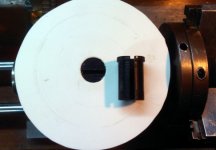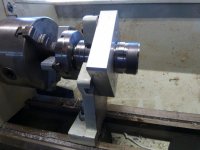I thought I would start a thread with tips that help out when using a lathe.
Hopefully others will chime in with other helpful tips for novice or expert alike.
When filing/snading something that is close to the chuck jaws, place a plastic washer over the part and against the jaws.
This stops the file from hitting against the chuck jaws or work holder.
Using 2 keys with a 4 jaw chuck allows for a lot quicker setting up as to just using the 1 key usually supplied. The do not need to be the same handle size, and sometimes a smaller handle is easier to use on the back or under side of the chuck.
Hopefully others will chime in with other helpful tips for novice or expert alike.
When filing/snading something that is close to the chuck jaws, place a plastic washer over the part and against the jaws.
This stops the file from hitting against the chuck jaws or work holder.
Using 2 keys with a 4 jaw chuck allows for a lot quicker setting up as to just using the 1 key usually supplied. The do not need to be the same handle size, and sometimes a smaller handle is easier to use on the back or under side of the chuck.





